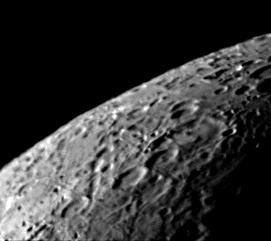Observing the Moon: The Rheita Valley Area
Jack Kramer
The Moon is easy to locate, full of detail, and unaffected by light pollution; in short, it's a great backyard target. Still, it "just don't get no respect". It's observable during a large part of each month, and therein lies the problem: it's often lighting up the sky when we want to observe something faint. This time, let's forgive the Moon its past sins and pay a visit to our nearest neighbor.
Early in the lunar month, near the limb in the southeast quadrant, there's a wealth of detail available to those looking for lunar scenery. One place worth a look is the Rheita Valley and nearby craters.

This image was taken by Michael Purcell shortly before the Moon set using a C14 telescope and an ST-6 CCD camera. This picture is oriented as the Moon would appear in a Newtonian telescope, with south up and east to the left.
The Rheita valley is a long gash extending toward the southeast from the south side of the crater Rheita. It's believed that part of the valley was the result of subsidence, while part had a different origin. The edges appear scalloped, giving the impression that it might have been partially formed as a string of overlapping craters. But that's a personal observation, rather than the opinion of an expert in selenography (the lunar equivalent of geography).
The crater Fabricius is rugged, with a high central peak. The wall appeared double during one observation, making it look as though one crater is almost perfectly centered in another. However, photographic atlases of the Moon don't confirm this; it may be one of those things that shows up only with certain angles of illumination. The above image by Michael Purcell was taken when the Moon was a fairly slim crescent, so the Sun had not risen quite high enough to illuminate the the apparently concentric walls of Fabricius. The following night would have probably shown them better. But if you were to observe a couple of days beyond that, the higher angle of the Sun would greatly reduce the amount of detail visible.
Just to the south of Fabricius is the large (180 km diam.), highly-eroded crater Janssen. The erosion, of course, isn't caused by any Lunar "weather", but by infalling cosmic debris, with perhaps some "moonquakes" thrown in. It appears as though Janssen was blasted by numerous impacts. Some interesting details here include an arc-shaped rille (small, narrow valley) across the floor and a multitude of newer craters superimposed on the walls of Janssen.
Just be sure to catch the Moon when it's a fairly thin crescent, because these details lose a lot of contrast just a few days later. Experienced Moon watchers know that features often take on substantially different appearances from night to night, and sometimes even over the span of an evening's observation.





